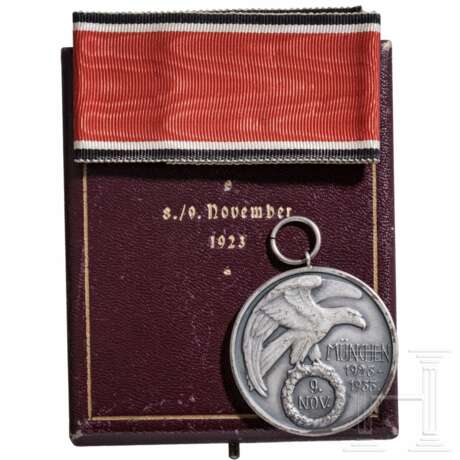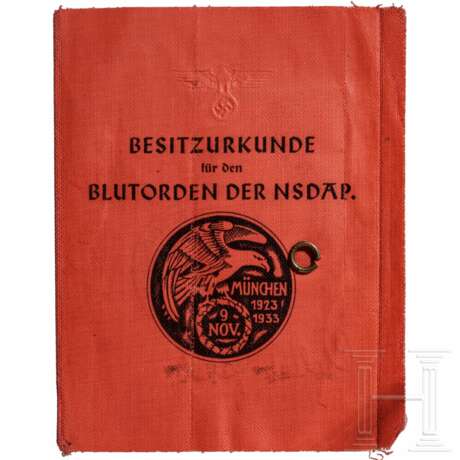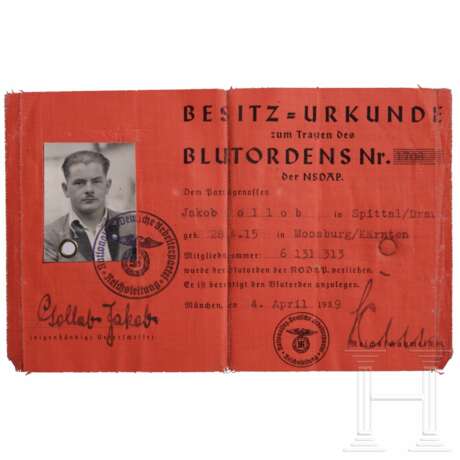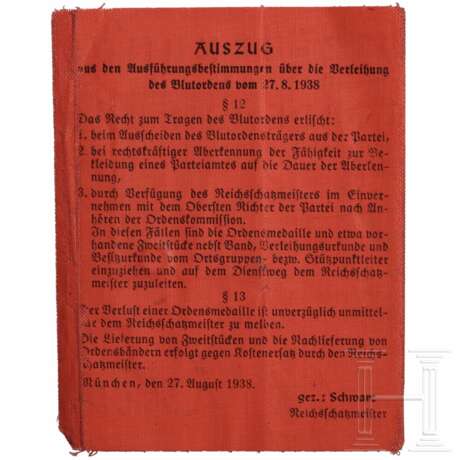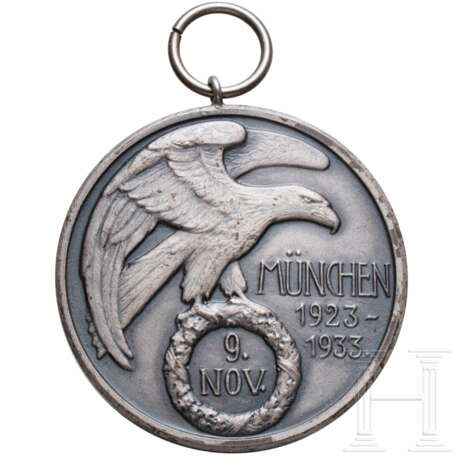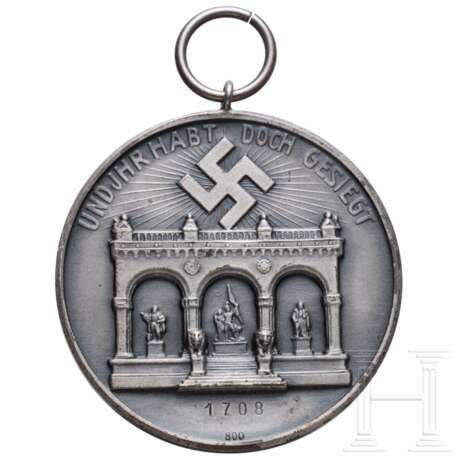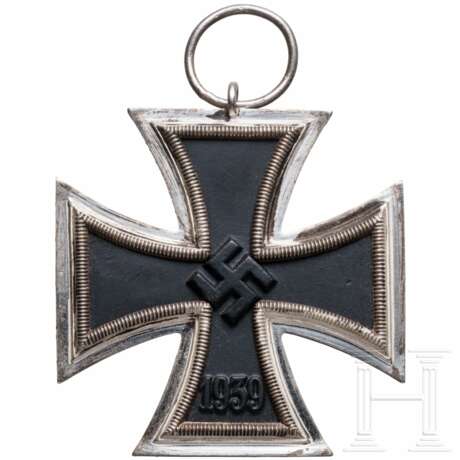ID 1413977
Lot 1361 | Nachlass des Blutordensträgers Jakob Gollob, 2. Modell "1708"
Ehrenzeichen vom 9. November 1923, sog. "Blutorden", 800er Silberpunze, Verleihungsnummer "1708", die Originaltönung ist sehr gut erhalten, Gewicht 22.55 g, ungetragen, mit dem orig. Band (Länge 39 cm) sowie dem Verleihungsetui. Das Etui außen mit Aufdruck "8./9. November 1923", das Etui schließt und öffnet einwandfrei, das Scharnier und der Drücker sind magnetisch. Die orig. Verleihungsurkunde, datiert "München, den 31. März 1939", unterschrieben vom Reichsschatzmeister Franz Xaver Schwarz, leider stark beschnitten, Maße 19,5 x 30 cm. Des Weiteren sein Ausweis (Besitz-Urkunde) zum Blutorden, datiert "4. April 1939", unterschrieben vom Inhaber und Reichsschatzmeister Franz Xaver Schwarz, sein Bild ist mit der typischen Messingöse befestigt.
Dazu Urkunde zum Eisernen Kreuz 2. Klasse 1939. Gollob war zu diesem Zeitpunkt Unteroffizier, Feldpostnummer 36663 (= 2. Gebirgs-Division), unterschrieben von Generalmajor Ernst Schlemmer. Dazu das Eiserne Kreuz 2. Klasse 1939, Eisenkern.
Sechs Nachkriegsdokumente: Gesuch um Entregistrierung, endgültige Entlassung, Haftbefehl (es wird erwähnt, dass er Blutordensträger war), Schreiben der Republik Österreich, bedingte Entlassung und ein Beschluss (Strafsache).
Wachtmeister Jakob Gollob wurde am 28. April 1915 in Moosburg (Kärnten) geboren. Um 1931 wurde er Mitglied der NSDAP. Gollob wurde mehrmals inhaftiert, weil er sich an NS-Aktionen in Österreich beteiligte. Im Jahr 1938 meldete er sich wieder bei der NSDAP (Nr. 6 131 313) an und wurde von Juni bis Oktober 1938 Ortsgruppenleiter der NSDAP in Baldramsdorf. Am 2. Dezember 1938 rückte er in die Wehrmacht ein und diente bis Kriegsende beim Gebirgsartillerie-Regiment 111. Er war im Polenfeldzug, in Finnland und an der Westfront und errang den Dienstgrad eines Wachtmeisters.
Ein äußerst seltener Nachlass.
An estate of Blood Order recipient Jakob Gollob, 2nd model "1708"
An estate of Blood Order recipient Jakob Gollob, 2nd model "1708"
Badge of Honour dated 9 November 1923, also known as "Blood Order", silver mark 800, award number "1708", the original colouring is well-preserved, weight 22.55 gr., unworn with the original ribbon (length 39 cm) and presentation case. The case on the outside with imprint "8./9. November 1923", the case can be opened and closed smoothly, the hinge and the press stud are magnetic. The original award document dated "München, den 31. März 1939", signed by Reichsschatzmeister Franz Xaver Schwarz, unfortunately cut back considerably, size 19.5 x 30 cm. Furthermore, his certificate (possession document) to the Blood Order dated "4. April 1939", signed by the owner and Reichsschatzmeister Franz Xaver Schwarz, his picture is attached with the characteristic brass loop. Comes with the document to the Iron Cross 2nd Class 1939. At that time, Gollob was non-commissioned officer, field post office number 36663 (= 2nd Mountain Division), signed by Major General Ernst Schlemmer. Also the Iron Cross 2nd Class 1939, iron centre.
Six post-war documents: application for deregistration, permanent discharge, warrant of arrest (stating that he was Blood Order recipient), letter by the Republic of Austria, discharge on probation and a decree (criminal matter).
Sergeant Jakob Gollob was born in Moosburg (Carinthia/Austria) on 28 April 1915. Around 1931, he became member of the NSDAP. Gollob was imprisoned several times for taking part in NS campaigns in Austria. In 1938, he registered again with the NSDAP (No. 6 131 313) and became Ortsgruppenleiter of the NSDAP in Baldramsdorf from June to October 1938. On 2nd December 1938, he joined the Wehrmacht and served in the Mountain Artillery Regiment 111 until the end of the war. He took part in the Polish Campaign, was in Finland and at the Western Front and achieved the rank of Wachtmeister (sergeant).
An extremely rare estate.
Condition: II +
| Auction house category: | Order groups and convolutes |
|---|
| Auction house category: | Order groups and convolutes |
|---|
| Address of auction |
Hermann Historica Bretonischer Ring 3 85630 Grasbrunn / München Germany | ||||||||||||||
|---|---|---|---|---|---|---|---|---|---|---|---|---|---|---|---|
| Preview | |||||||||||||||
| Phone | +49 (0)89 5472 649 0 | ||||||||||||||
| Fax | +49 (0)89 5472 64999 | ||||||||||||||
| Buyer Premium | 25 % | ||||||||||||||
| Conditions of purchase | Conditions of purchase | ||||||||||||||
| Business hours | Business hours
|


